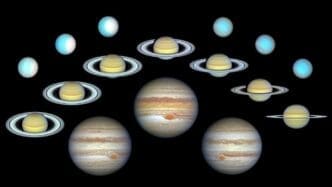Over the past decade, NASA’s Hubble Space Telescope has meticulously documented the atmospheric dynamics of the solar system’s outer planets, offering a glimpse into the weather patterns of Jupiter, Saturn, Uranus, and Neptune.
NASA’s Outer Planet Atmospheres Legacy (OPAL) program has harnessed the capabilities of the Hubble Space Telescope to study the long-term atmospheric changes on some of the most distant planets in our solar system. This initiative has provided astronomers with crucial data to understand the climatic variations and weather phenomena of these gas giants.
Spanning over ten years, the program’s observations have been pivotal in tracking changes within the atmospheric conditions of these planets. “Because OPAL now spans 10 years and counting, our database of planetary observations is ever growing. That longevity allows for serendipitous discoveries, but also for tracking long-term atmospheric changes as the planets orbit the sun,” stated Amy Simon from NASA’s Goddard Space Flight Center.
Jupiter, the largest planet in our solar system, has undergone detailed scrutiny under the OPAL program. The planet’s notorious Great Red Spot has shown variations in its size and shape over the years. Jupiter’s atmosphere is characterized by its swirling gases, which reach down to its core. The planet’s minimal axial tilt results in slight seasonal variations, providing a relatively stable atmosphere over its 12-year orbit around the Sun.
Saturn, with its iconic rings, displays a much greater degree of seasonal change due to its axial tilt of 26.7 degrees and its 29-year orbit. Over the last decade, observations have captured changes in color and cloud depth in its atmosphere, along with a better understanding of the elusive dark ring spokes—believed to be a seasonal occurrence first discovered in the 1980s.
Uranus presents a unique case, with its extreme axial tilt causing the planet to rotate on its side. Over the course of Hubble’s observations, the increasing brightness of Uranus’ north polar cap has been noted, as it slowly approaches its summer solstice. Each orbit around the Sun takes Uranus 84 years, making these observations significant in understanding its atmospheric behavior.
Neptune, the farthest of the four, has been closely watched as its atmospheric storms develop and dissipate. Notably, Hubble documented a large dark storm in 2018, tracking its movement until it faded towards the planet’s equator. Subsequent observations in 2021 followed a similar pattern. These storm activities appear to be linked to the solar cycle, which also influences northern lights on Earth.
The decade-long observational campaign by the Hubble Space Telescope has significantly advanced our comprehension of the intricate weather systems on our solar system’s outer planets. Through programs like OPAL, scientists continue to gather invaluable insights into these distant worlds.
Source: Space







